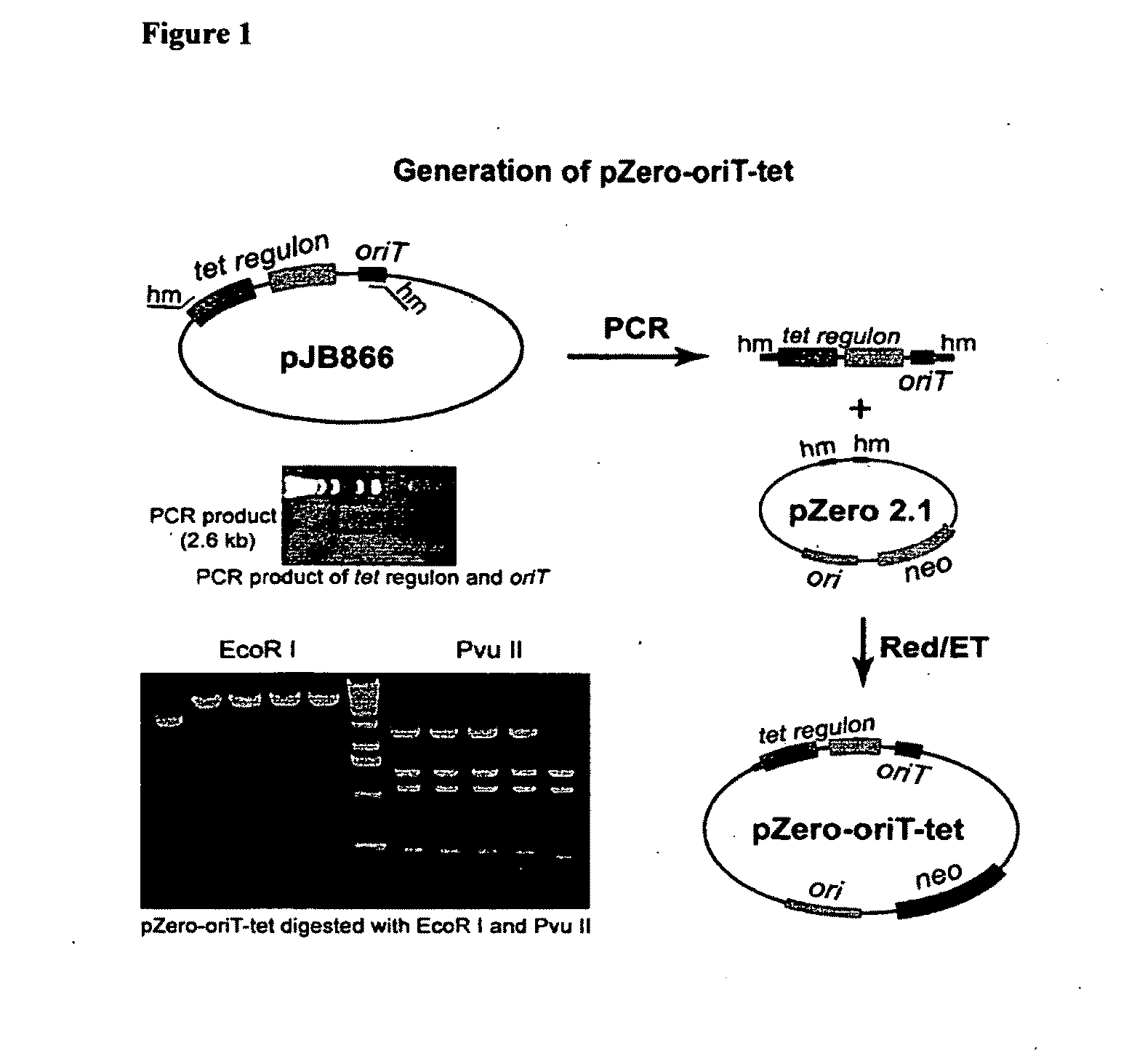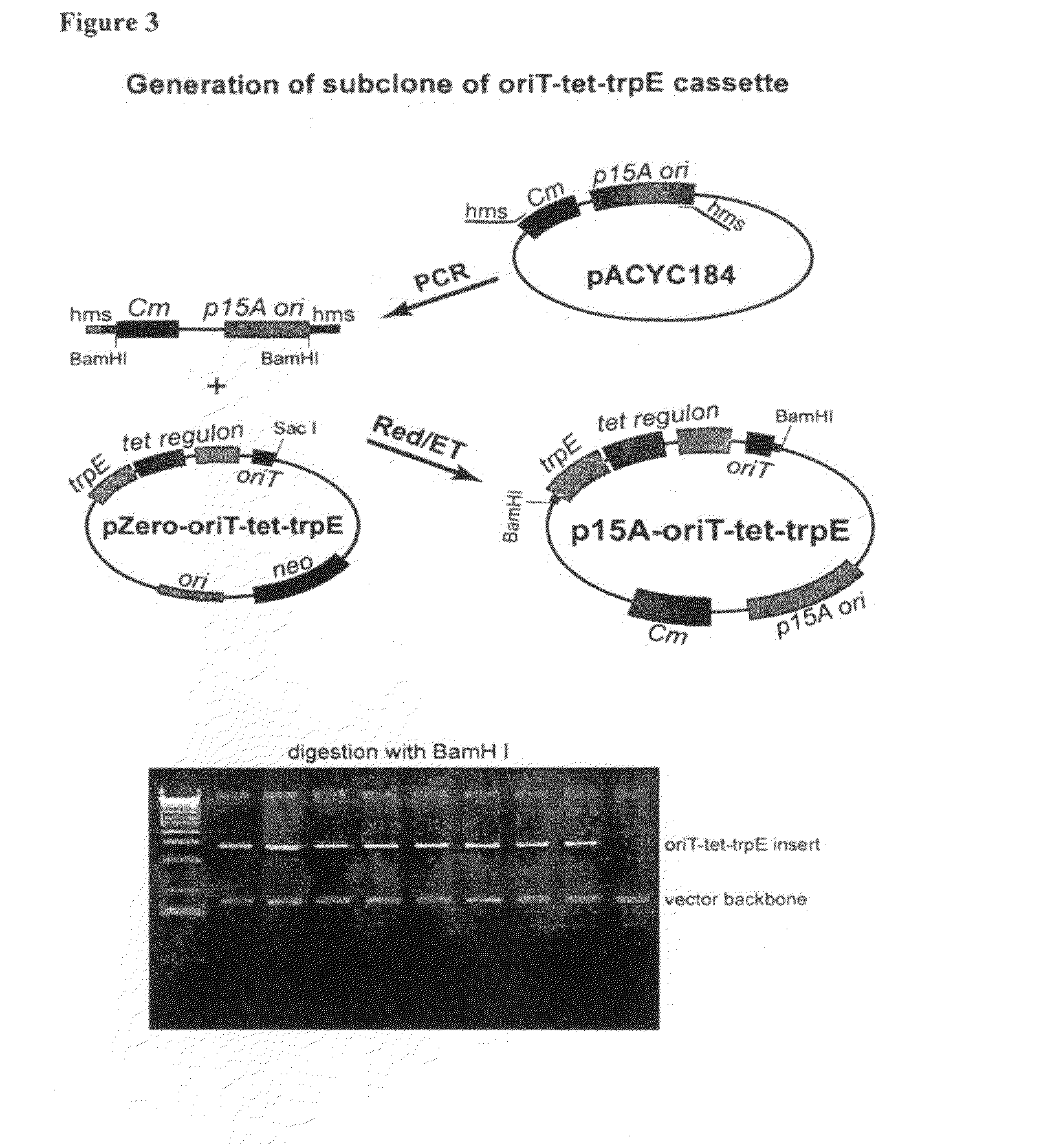Methods for heterologous expression of secondary metabolites
a secondary metabolite and heterologous technology, applied in the field of methods for heterologous expression of secondary metabolites, can solve the problems of limited in situ host-by-host approaches for mutagenesis of secondary metabolite pathways, low mutagenesis efficiency of i>e. coli/i> and other heterologous host cells, and poor development of dna mutagenesis technology, etc., to achieve efficient integration into the endogenous genome, improve the effect o
- Summary
- Abstract
- Description
- Claims
- Application Information
AI Technical Summary
Benefits of technology
Problems solved by technology
Method used
Image
Examples
example 1
Synthesis of the Type I Polyketide / Nonribosomal Peptide Myxochromide in P. putida
[0097]The invention is described below in an example in which a complete myxobacterial pathway for the synthesis of the type I polyketide / nonribosomal peptide myxochromide is engineered in E. coli and then transferred to Pseudomonas putida by conjugation, using a BAC or cosmid vector comprising an oriT conjugation region.
A. Engineering of pSuperCos-Myxochromide to Introduce the Conjugation Origin and Tetracycline Inducible Regulon.
[0098]PCR was used to generate an oriT-tetR fragment. oriT is the sequence used for conjugation between bacterial species. TetR is a tetracyline regulon and consists of the let regulator and the let resistant gene. The oriT-tetR fragment was inserted into the pZeo2.1 vector (Invitrogen) by recombineering (FIG. 1). Next, the trpE gene from Pseudomonas was inserted into the oriT-tetR cassette using recombineering (FIG. 2). The trpE gene is in this instance used as homology for ...
example 2
Pseudomonas is Able to Express Type III PKS
A) Introduction
[0104]In the course of the ongoing genome sequencing project of Sorangium cellulosum So ce56 homology searches with the BLAST program were performed. An open reading frame was identified, which shows homology to type III polyketides from bacteria. The encoded protein has about 70% identity with the 1,3,6,8-tetrahydroxynaphtalene synthase (RppA) from several streptomycetes. This enzyme is responsible for the production of 1,3,6,8-tetrahydroxynaphtalene, which oxidises spontaneously to flaviolin. From the extent of homology to RppA, it could be assumed that the product of the reaction catalysed by this enzyme would be 1,3,6,8-tetrahydroxynaphtalene or flaviolin, respectively. Such a compound is undetected to date in Sorangium cellulosum So ce56, although the screening program performed with this strains was extensive. The compound has not been found in any myxobacterium. The assumption is that the corresponding gene is silent i...
example 3
Evaluation of Pseudomonas Strains for PPANT Transferase Activity
[0107]We demonstrated the ability of Pseudomonas putida KT2440, Pseudomonas syringae pv. tomato DC3000 and Pseudomonas stutzeri DSM10701 to posttranslationally activate carrier protein domains of polyketide synthases, nonribosomal peptide synthetases and fatty acid synthase by their intrinsic phosphopantetheinyl transferase. The apo-form is modified to the holo-form of the carrier protein through attachment of a phosphopantetheine moiety from coenzyme A to a conserved serine residue of the carrier protein (domain). We cloned the coding region of the respective domains in order to generate C-terminal fusions with intein-chitin binding domain. The constructs were subcloned into a broad host range vector and transferred into the three Pseudomonas hosts. Resulting recombinant Pseudomonas strains were cultivated and each fusion protein was purified by affinity chromatography.
[0108]The purified carrier protein was analysed us...
PUM
 Login to View More
Login to View More Abstract
Description
Claims
Application Information
 Login to View More
Login to View More - R&D
- Intellectual Property
- Life Sciences
- Materials
- Tech Scout
- Unparalleled Data Quality
- Higher Quality Content
- 60% Fewer Hallucinations
Browse by: Latest US Patents, China's latest patents, Technical Efficacy Thesaurus, Application Domain, Technology Topic, Popular Technical Reports.
© 2025 PatSnap. All rights reserved.Legal|Privacy policy|Modern Slavery Act Transparency Statement|Sitemap|About US| Contact US: help@patsnap.com



